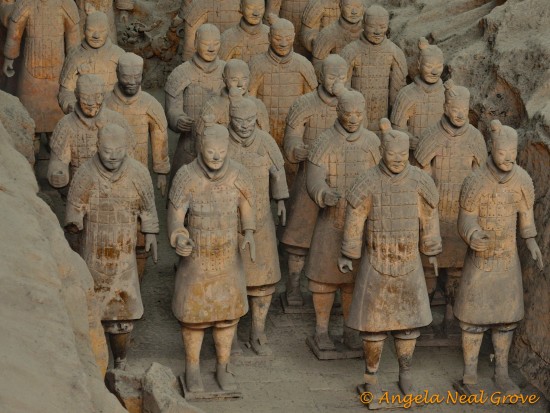
When I stood in the vast hangar-like museum at Xian and gazed at the life-sized army of marching men, horses and chariots I understood why some call the Terracotta Warrior site the 8th wonder of the world.
They march in silence. Generals, lieutenants, cavalry, foot-soldiers, archers, horses and chariots, enigmatic emissaries for their emperor escorting him to eternity. Over six feet high they towered above the diminutive stature of Queen Elizabeth II when, on an official visit to China, she stood taking in the scope of the army.
one of the world’s largest tomb complexes
covering an area the size of Manhattan
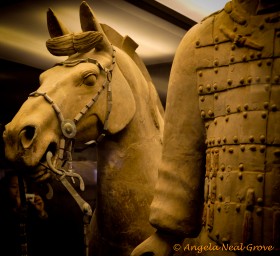
The warriors, some 2,200 years old, were discovered in 1974 twenty-five miles northeast of Xian, historic terminus of the Ancient Silk Road. Farmers, drilling a water well, found pottery fragments and ancient bronze weapons. The head of the village summoned authorities. Archaeological excavations began. What they had found were the underground vaults and burial mounds of Emperor Qin, one of the world’s largest tomb complexes covering an area the size of Manhattan.
Preliminary excavations discovered six hundred pits. So far three pits of soldiers, horses and chariots have been excavated and enclosed in the four acre Museum of Qin Terracotta Warriors and Horses which opened in 1979. Surrounding this museum the burial mounds are clearly visible. Endless treasures maybe found in them and these will reveal much about the world of the Emperor. Recently jugglers and vaults of birds have been found. This complex which took forty years to build is an incredible time capsule.
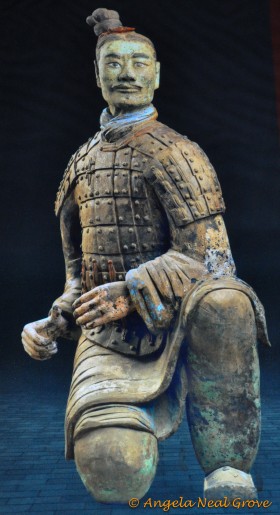
Sima Qian born in 135 BC wrote that the tomb contained a world with mountains of gold, stars represented by pearls, jewels and flowing rivers of mercury replicating the Yellow and Yangtze rivers. Traces of mercury have indeed been found in the soil of some of the mounds. Serious issues, however, face archaeologists.
Originally the terracotta warriors were painted. Once excavated, what remains of the fragile coloring is lost within minutes of contact with the air. Work continues on how to preserve this and excavations are limited pending an answer. There is a concern that paper, silk and textiles may disintegrate when they are unearthed. Respect for ancestors also means that care must be taken of treasures and the Emperor should not be disturbed.
What is known is that Emperor Qin, who was 49 when he died, changed his world. Emperor at the age of 13, his kingdom, celebrated for its horsemen, was surrounded by warring states which he began to conquer in his early 20’s. He created a huge empire and then introduced a uniform writing script which enabled those of different dialects and regions to communicate effectively. A system of civil administration was devised that endured for centuries. Weights and measures were standardized, including weapons.
To protect his new empire he reinforced borders against nomadic maurauders creating the foundations of the Great Wall of China. Qin’s infrastructure also included roads, irrigation canals and graineries.
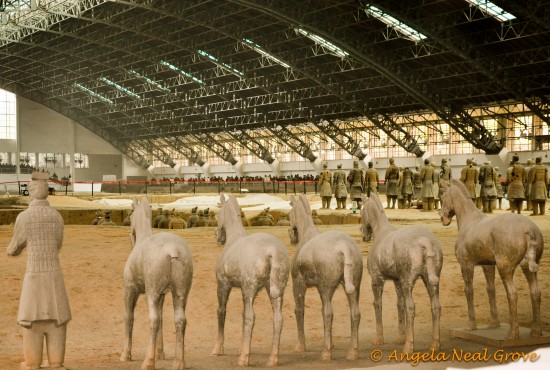
Emperor Qin craved immortality. He was so serious about it he sent his most revered alchemists to search for life-preserving elixirs. They were unsuccessful. However, the massive tomb complex he planned means his legacy will march on indefinitely.
Some of the warriors which were awakened in 1974 have been chosen as emmissaries and travel the world. Eight warriors and two horses, along with ceramics, jade and other treasures of the era will be at the Asian Art Museum in San Francisco from February 22 – May 27
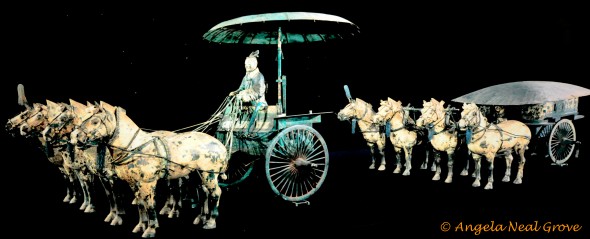
Angela is at her best! She brings us current on the remarkable Terracotta Warriors relevant at the moment since they are on exhibit presently at the SF Asian Art Museum.